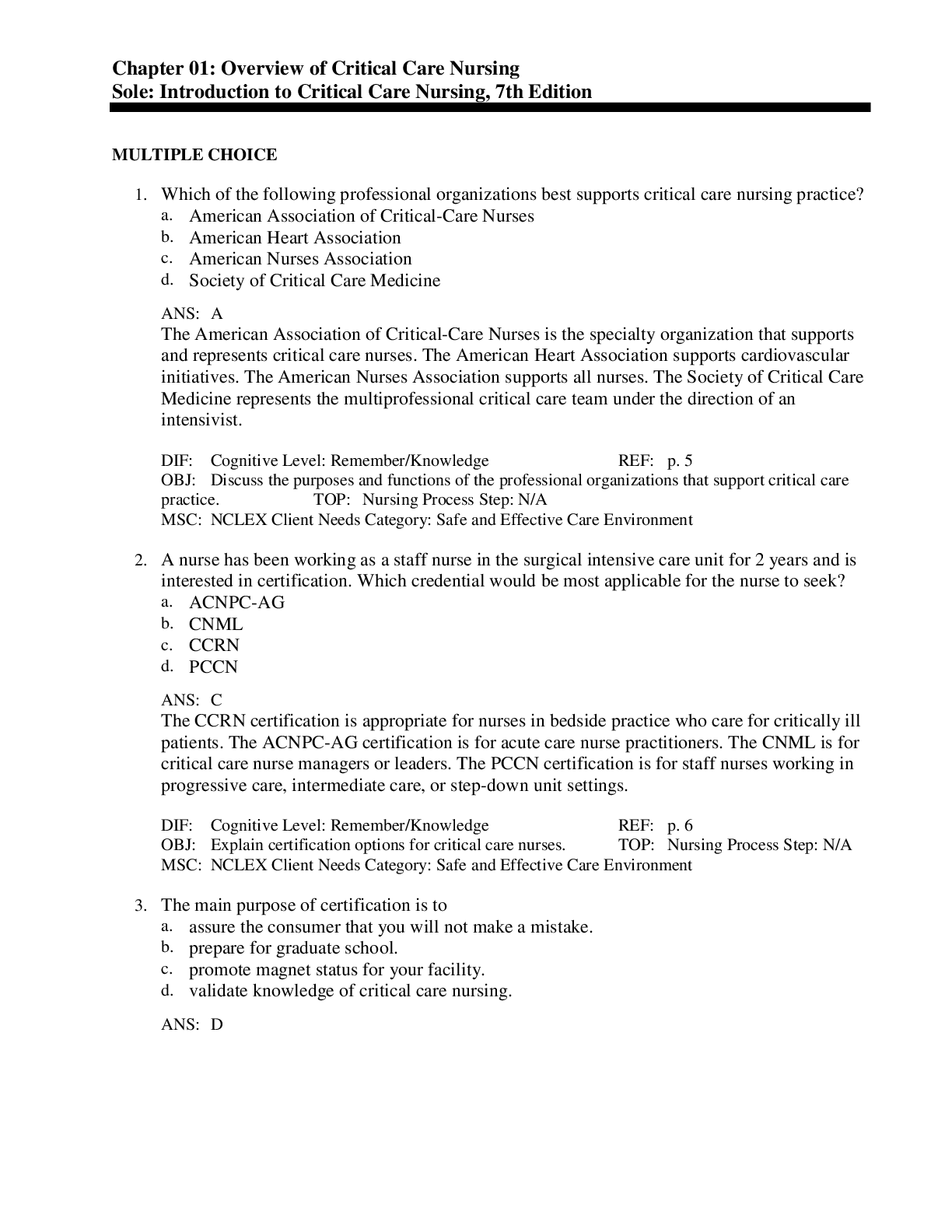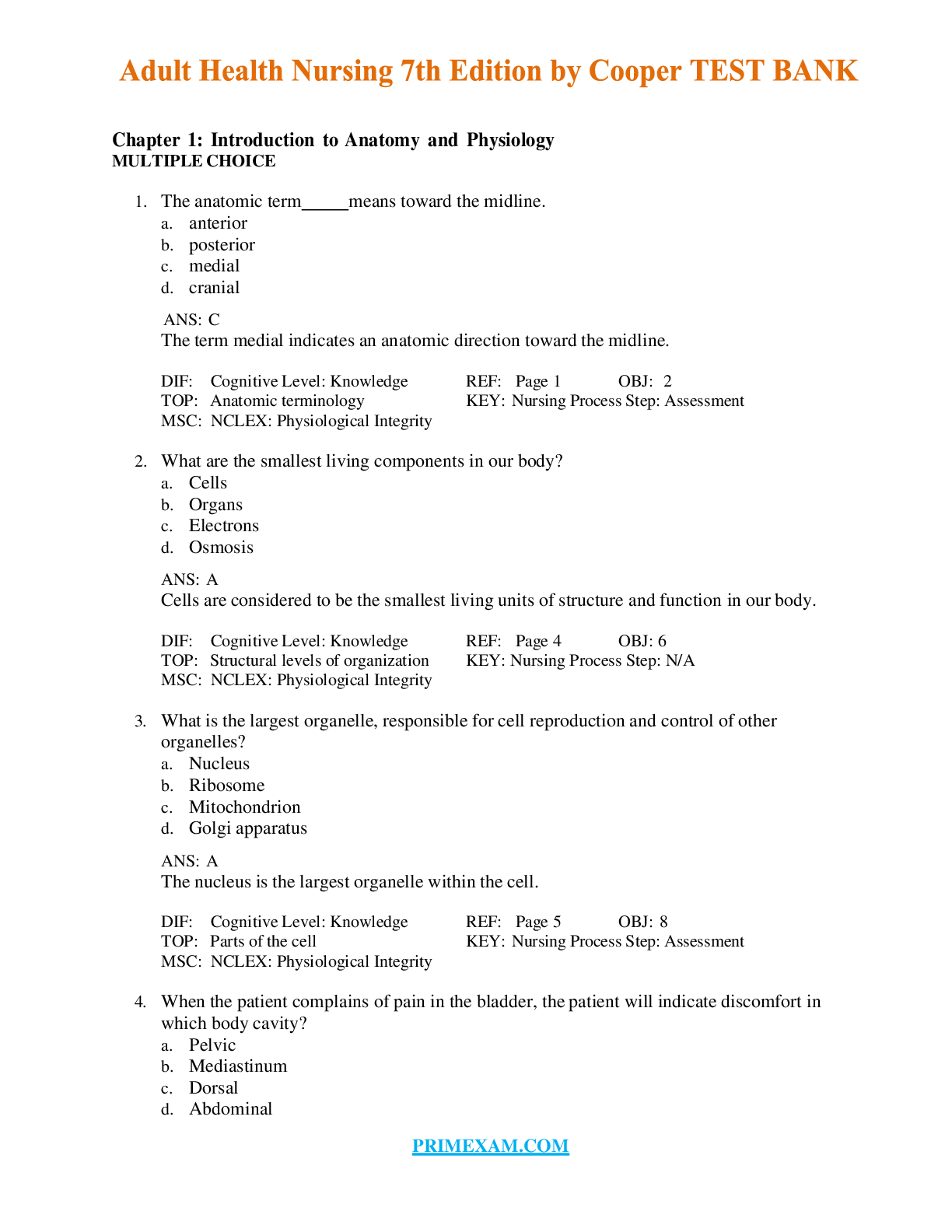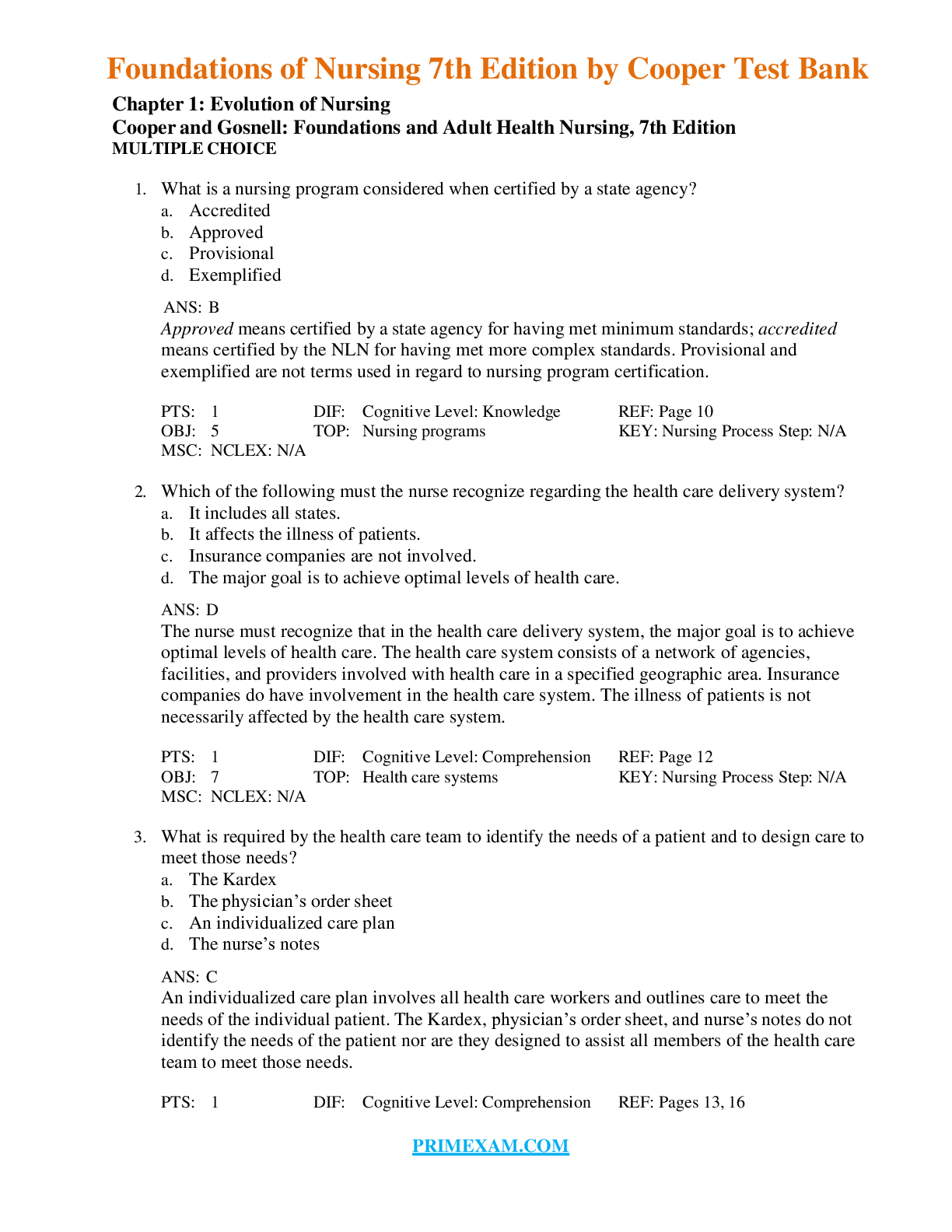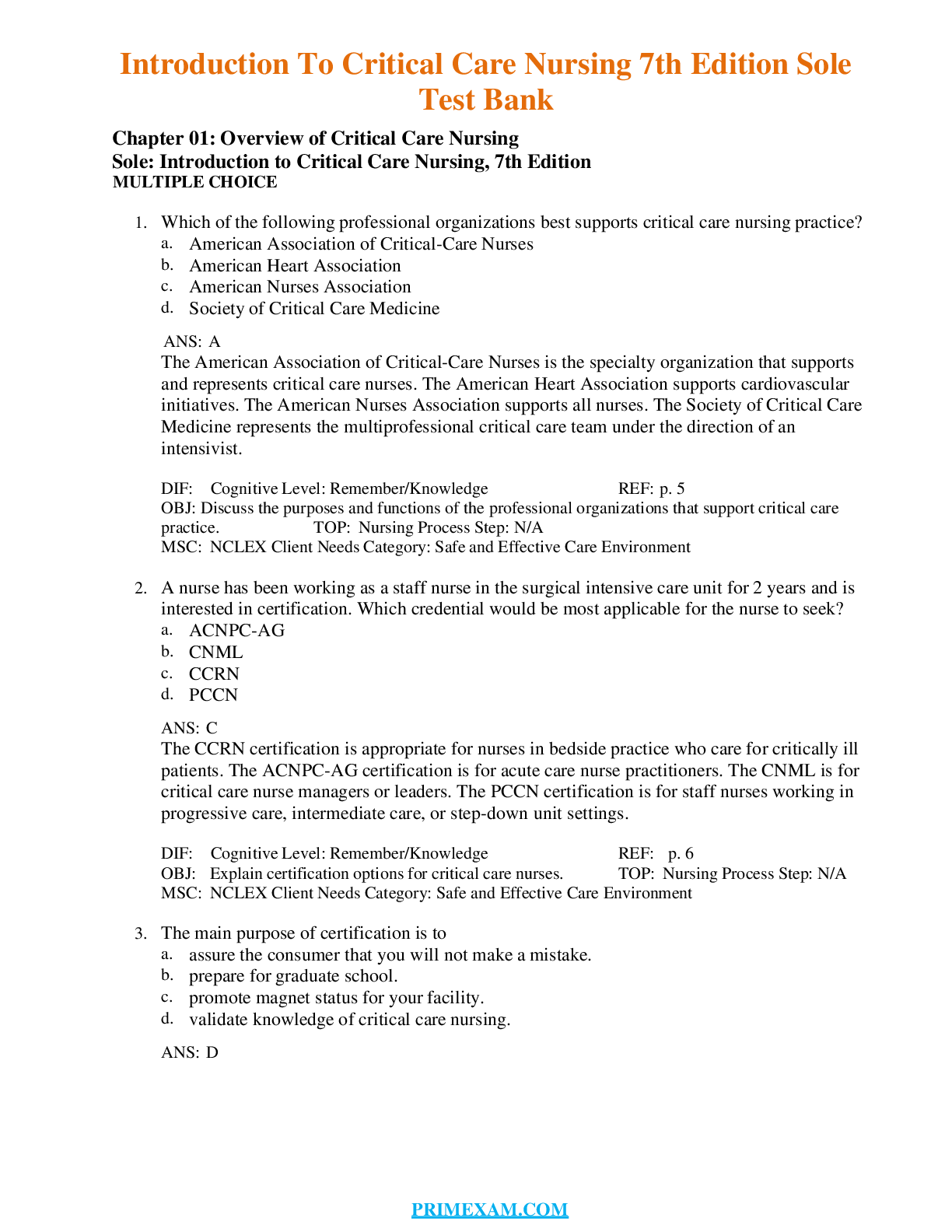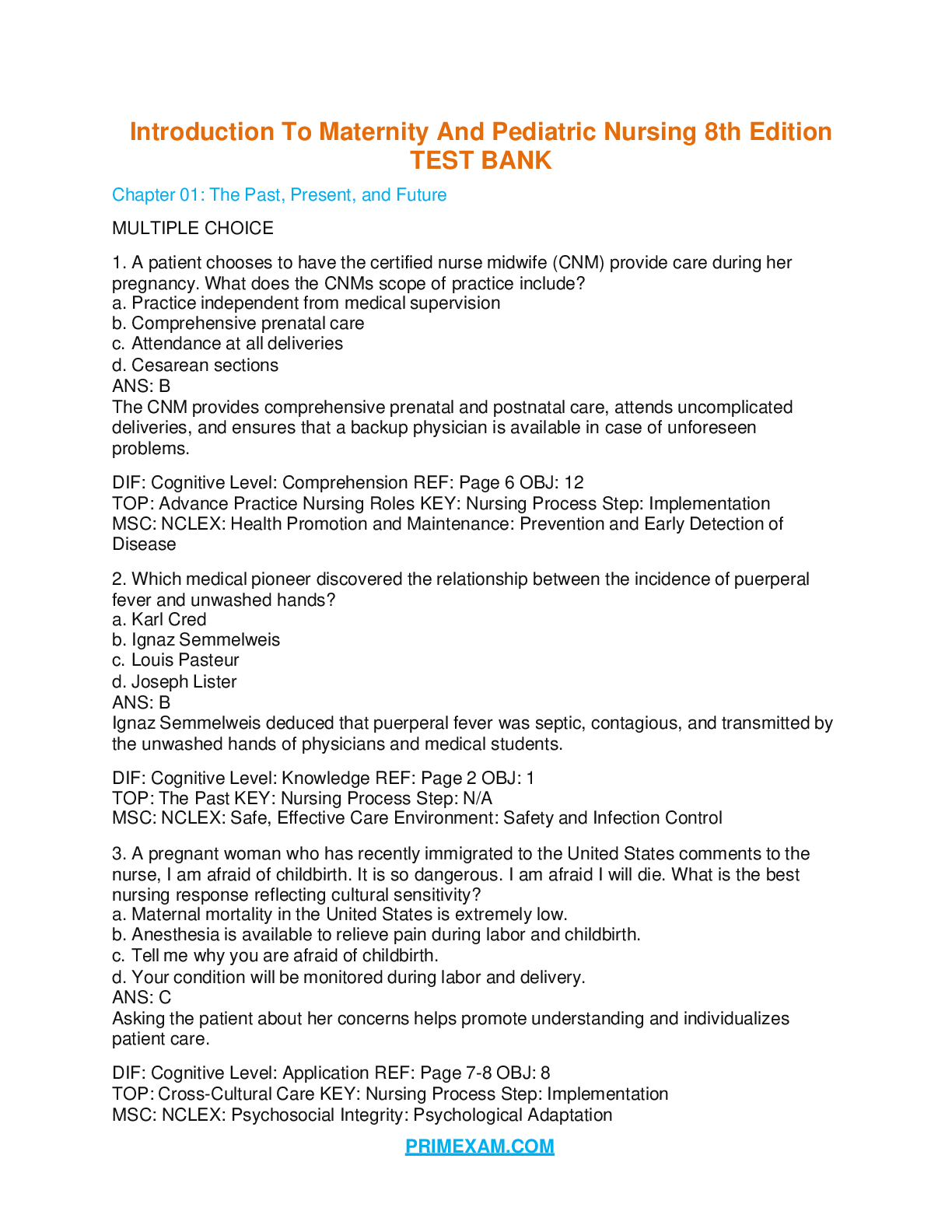*NURSING > TEST BANK > INTRODUCTION TO MATERNITY AND PEDIATRIC NURSING 7TH EDITION LEIFER TEST BANK: The Nurse’s Role in (All)
INTRODUCTION TO MATERNITY AND PEDIATRIC NURSING 7TH EDITION LEIFER TEST BANK: The Nurse’s Role in Women’s HealthCare,100% CORRECT
Document Content and Description Below
INTRODUCTION TO MATERNITY AND PEDIATRIC NURSING 7TH EDITION LEIFER TEST BANK: The Nurse’s Role in Women’s HealthCare Chapter 11: The Nurse’s Role in Women’s Health Care MULTIPLE CHOICE 1... . The nurse is preparing a community education program on preventive health care for women. What common screening test will the nurse plan on explaining to the women attending the program? a. Breast examination by a health professional b. Breast self-examination c. Breast biopsy d. Mammography ANS: D Mammography is a screening test used to detect breast cancer. DIF: Cognitive Level: Comprehension REF: Page 251 OBJ: 2 TOP: Mammography KEY: Nursing Process Step: Planning MSC: NCLEX: Health Promotion and Maintenance: Prevention and Early Detection of Disease 2. The nurse reviews the procedure for breast self-examination (BSE) with a 25-year-old woman who has a family history of breast cancer. When reviewing the procedure, when will the nurse indicate as the best time for a woman to perform a breast self-examination? a. A few days before her period b. During her menstrual period c. On the last day of menstrual flow d. One week after the beginning of her period ANS: D The best time for BSE is 1 week after the beginning of the menstrual period. DIF: Cognitive Level: Knowledge REF: Page 251 OBJ: 2 TOP: Breast Self-Exam KEY: Nursing Process Step: Implementation MSC: NCLEX: Health Promotion and Maintenance: Prevention and Early Detection of Disease 3. A woman asks the nurse, “How do oral contraceptives prevent pregnancy?” What will the nurse explain about the combination of estrogen and progesterone in oral contraceptives? a. Makes cervical mucus hostile to sperm b. Prevents ovulation c. Prohibits implantation of the egg d. Acts as a barrier by destroying sperm ANS: B Oral contraceptives contain a combination of estrogen and progesterone that suppresses ovulation. DIF: Cognitive Level: Comprehension REF: Page 262 OBJ: 5 TOP: Oral Contraceptives KEY: Nursing Process Step: Implementation MSC: NCLEX: Physiological Integrity: Pharmacological Therapies 4. What should a woman expect after insertion of an intrauterine device (IUD)? a. Menstrual flow will be lighter. b. Menstrual cramps will be eliminated. c. A string should be felt in the vagina. d. The device should be changed every 2 years. ANS: C A woman should feel for the string periodically, especially after her period, to confirm the presence of the IUD. DIF: Cognitive Level: Comprehension REF: Page 264 OBJ: 5 TOP: IUDs KEY: Nursing Process Step: Implementation MSC: NCLEX: Physiological Integrity: Physiological Adaptation 5. What information will the nurse provide when educating a woman about the correct use of a diaphragm? a. Use of a spermicidal cream or jelly is not recommended. b. Leave in place for at least 6 hours after intercourse. c. Remove immediately after intercourse for douching. d. It is effective for up to 48 hours if positioned properly. ANS: B To act as a barrier, the diaphragm must be left in place for at least 6 hours after intercourse and can be left in place up to 24 hours. DIF: Cognitive Level: Comprehension REF: Page 264-265 OBJ: 5 TOP: Diaphragm KEY: Nursing Process Step: Evaluation MSC: NCLEX: Health Promotion and Maintenance: Prevention and Early Detection of Disease 6. The nurse is providing sexual education to a group of high school students. What will the nurse explain is the most effective choice of birth control for preventing pregnancy and sexually transmitted diseases? a. Abstain from sex. b. Use the male condom. c. Use the female condom. d. Use the barrier method. ANS: A Abstinence is 100% effective in preventing pregnancy and sexually transmitted diseases. DIF: Cognitive Level: Comprehension REF: Page 262 OBJ: 5 TOP: Abstinence KEY: Nursing Process Step: Implementation MSC: NCLEX: Health Promotion and Maintenance: Prevention and Early Detection of Disease 7. On day 13 of a 28-day cycle, a woman’s basal body temperature is 36.5° C (97.7° F). What will her temperature measurement most likely be if ovulation takes place on day 14? a. 35.9° C (96.7° F) b. 36.3° C (97.3° F) c. 36.7° C (98.1° F) d. 37.1° C (98.9° F) ANS: C At the time of ovulation, body temperature will increase slightly, about 0.2° C (0.4° F). DIF: Cognitive Level: Analysis REF: Page 261 OBJ: 6 TOP: Ovulation KEY: Nursing Process Step: Implementation MSC: NCLEX: Physiological Integrity: Physiological Adaptation 8. The nurse tells a woman who is trying to conceive to check her cervical mucus for changes. What will she expect the characteristic of cervical mucus to be a few days before ovulation? a. Cloudy and tacky b. Scant and thick c. Thin and white d. Clear and slippery ANS: D Within a few days of ovulation, cervical mucus will become clear and slippery to aid the passage of sperm into the cervix. DIF: Cognitive Level: Knowledge REF: Page 261 OBJ: 6 TOP: Ovulation KEY: Nursing Process Step: Implementation MSC: NCLEX: Physiological Integrity: Physiological Adaptation 9. The nurse is discussing cervical mucus changes with a woman who wishes to use natural family planning methods. What information about cervical mucus at ovulation will the woman indicate to the nurse, demonstrating that learning has taken place? a. Cervical mucus enhances the motility of the sperm. b. Cervical mucus indicates endometrial readiness for implantation. c. Cervical mucus facilitates movement of the ovum through the fallopian tube. d. Cervical mucus provides vaginal lubrication during intercourse. ANS: A Around the time of ovulation, the slippery, clear cervical mucus enhances the motility of the sperm. DIF: Cognitive Level: Comprehension REF: Page 261 OBJ: 6 TOP: Cervical Mucus KEY: Nursing Process Step: Evaluation MSC: NCLEX: Physiological Integrity: Physiological Adaptation 10. In the week before her menstrual period, a woman experiences irritability, anxiety, and difficulty concentrating. What remedy might the nurse suggest to relieve these symptoms? a. Drink tea or hot chocolate before going to bed. b. Take a daily folic acid and vitamin C supplement. c. Include complex carbohydrates and fiber in the diet. d. Avoid exercise when symptoms occur. ANS: C A diet rich in complex carbohydrates and fiber is recommended for premenstrual dysmorphic disorder. DIF: Cognitive Level: Application REF: Page 254 OBJ: 3 TOP: Premenstrual Dysmorphic Disorder KEY: Nursing Process Step: Implementation MSC: NCLEX: Physiological Integrity: Physiological Adaptation 11. The nurse explains that the drug clomiphene (Clomid) is used in infertility treatment. What is the primary action of clomiphene (Clomid)? a. Induces ovulation b. Reduces endometriosis c. Promotes implantation of a fertilized ovum d. Inhibits excess prolactin secretion ANS: A Clomiphene (Clomid) induces ovulation. It may also increase sperm production, although this is an unlabeled use. DIF: Cognitive Level: Knowledge REF: Page 272 OBJ: 7 TOP: Clomid KEY: Nursing Process Step: Implementation MSC: NCLEX: Physiological Integrity: Pharmacological Therapies 12. At her regular gynecological examination, a woman tells the nurse that she is concerned about osteoporosis. What suggestion can the nurse make to this patient? a. Take a vitamin E supplement daily. b. Do isometric exercises that can be practiced every day. c. Include more dairy products and green, leafy vegetables in her diet. d. Try to limit her intake of caffeine. ANS: C Foods rich in calcium include milk, dairy products, and green, leafy vegetables. DIF: Cognitive Level: Application REF: Page 275 OBJ: 8 TOP: Prevention of Osteoporosis KEY: Nursing Process Step: Implementation MSC: NCLEX: Health Promotion and Maintenance: Prevention and Early Detection of Disease 13. A 48-year-old woman tells the nurse, “I missed my period last month. Am I in menopause?” The nurse knows that at which point is a woman considered to be menopausal? a. Her periods have stopped for 1 year. b. Her periods have been irregular and light for 12 months. c. She has symptoms of vasomotor instability. d. She experiences symptoms of decreased estrogen, such as dyspareunia. ANS: A When a woman’s menstrual periods have stopped for 1 year, she is considered menopausal. DIF: Cognitive Level: Comprehension REF: Page 274 OBJ: 8 TOP: Menopause KEY: Nursing Process Step: Implementation MSC: NCLEX: Physiological Integrity: Physiological Adaptation 14. The nurse is planning to teach a woman about perimenopause. What would the nurse include regarding lowered estrogen level? a. It prevent osteoporosis. b. It decreases vaginal lubrication. c. It raises the level of low-density lipoproteins. d. It raises the level of high-density lipoproteins. ANS: C Estrogen increases the amount of high-density lipoproteins that carry cholesterol from body cells to the liver for excretion. With lowered levels of estrogen, low-density lipoproteins increase, causing an increase in the incidence of heart attacks and strokes. DIF: Cognitive Level: Knowledge REF: Page 274 OBJ: 8 TOP: Menopause KEY: Nursing Process Step: Planning MSC: NCLEX: Physiological Integrity: Physiological Adaptation 15. What side effect would the nurse instruct a woman to look for when starting hormone replacement therapy (HRT)? a. Fatigue b. Headache c. Weight loss d. Amenorrhea ANS: B Patients initiating HRT are reminded to have regular follow-up care and report headaches, vision changes, symptoms of thrombophlebitis, and cardiac symptoms. DIF: Cognitive Level: Comprehension REF: Page 275 OBJ: 8 TOP: HRT KEY: Nursing Process Step: Implementation MSC: NCLEX: Physiological Integrity: Physiological Adaptation 16. What will the nurse advise when a woman asks what she can do to reduce the discomfort of hot flashes? a. “Aerobic exercise helps control hot flashes.” b. “Increase the amount of calcium and vitamin D in your diet.” c. “Dress in layers of cotton clothing.” d. “Drink plenty of fluids, particularly caffeinated beverages.” ANS: C Cotton allows easier passage of air than synthetic fabrics. Layering allows the woman to take off or put on clothes when symptoms occur. DIF: Cognitive Level: Application REF: Page 276, NCP 11-1 OBJ: 8 TOP: Prevention of Hot Flashes KEY: Nursing Process Step: Implementation MSC: NCLEX: Physiological Integrity: Physiological Adaptation 17. Which statement made by the nurse would teach an adolescent using tampons how to prevent toxic shock syndrome (TSS)? a. Super-absorbency tampons are effective for overnight absorption. b. Tampons should be changed at least every 4 hours. c. Gloves should be worn when changing tampons. d. TSS can be prevented by using a pad for the first 2 days of menstrual flow. ANS: B Tampons should be changed every 4 hours because a blood-soaked tampon is an excellent environment for bacteria. DIF: Cognitive Level: Comprehension REF: Page 255 OBJ: 4 TOP: TSS KEY: Nursing Process Step: Implementation MSC: NCLEX: Health Promotion and Maintenance: Prevention and Early Detection of Disease 18. What statement by a man considering a vasectomy indicates a need for further information? a. “Sterility does not occur immediately after the procedure.” b. “We will need to use some form of birth control for about a month afterward.” c. “The procedure involves the use of local anesthesia.” d. “I’ll need to remain in the hospital for a few days.” ANS: D A vasectomy takes about 20 minutes and is performed on an outpatient basis under local anesthesia. DIF: Cognitive Level: Analysis REF: Page 268 OBJ: 5 TOP: Vasectomy KEY: Nursing Process Step: Evaluation MSC: NCLEX: Physiological Integrity: Physiological Adaptation 19. At her 6-week postpartum checkup, a woman states, “I am wondering about birth control. I used oral contraceptives before, and I’m breastfeeding now. Can I use the pill again?” What is the nurse’s best response? a. “You should know that oral contraceptives increase your milk production.” b. “Oral contraceptives can be taken once lactation is well established.” c. “You don’t need to use any form of birth control as long as you are breastfeeding.” d. “Oral contraceptives are contraindicated for the lactating woman.” ANS: B Oral contraceptives decrease breast milk production and are contraindicated until lactation is well established. Women who breastfeed their infants usually will not ovulate for 10 weeks and do not need contraception until that time. DIF: Cognitive Level: Application REF: Page 263 OBJ: 5 TOP: Oral Contraceptives KEY: Nursing Process Step: Implementation MSC: NCLEX: Physiological Integrity: Physiological Adaptation 20. A 17-year-old girl comes to the emergency department complaining of severe pain in her left lower quadrant. An ovarian cyst is suspected. The nurse knows that what confirms this diagnosis? a. Laparotomy b. Oophorectomy c. Transvaginal ultrasound d. Hysteroscopy ANS: C Diagnosis of an ovarian cyst is made by transvaginal ultrasound. DIF: Cognitive Level: Analysis REF: Page 278 OBJ: 10 TOP: Ovarian Cysts KEY: Nursing Process Step: Implementation MSC: NCLEX: Physiological Integrity: Reduction of Risk 21. A 21-year-old college student has come to see the nurse practitioner for treatment of a vaginal infection. Physical assessment reveals inflammation of the vagina and vulva, and vaginal discharge has a cottage cheese appearance. With what are these findings consistent? a. Candidiasis b. Trichomoniasis c. Bacterial vaginosis d. Chlamydia ANS: A The signs and symptoms of candidiasis include inflammation of the vagina and vulva and a cottage cheese appearance to the vaginal discharge. DIF: Cognitive Level: Analysis REF: Page 257, Table 11-1 OBJ: 4 TOP: Candidiasis KEY: Nursing Process Step: Data Collection MSC: NCLEX: Health Promotion and Maintenance: Prevention and Early Detection of Disease 22. The nurse is providing an informational session on oral contraceptives. Which of the following decrease effectiveness of oral contraceptives? a. Antihistamines for seasonal allergies b. Iron preparations for treatment of anemia c. Appetite suppressants for weight reduction d. Anticonvulsants for treatment of epilepsy ANS: D Anticonvulsants decrease the effectiveness of oral contraceptives. DIF: Cognitive Level: Comprehension REF: Page 263 OBJ: 5 TOP: Oral Contraceptives KEY: Nursing Process Step: Implementation MSC: NCLEX: Physiological Integrity: Pharmacological Therapies 23. The nurse is instructing a man considering a vasectomy. What instruction will the nurse provide to address the postoperative time period? a. Intercourse should be delayed for 6 weeks. b. Sperm will still be ejaculated for a month. c. Erections will be difficult to maintain. d. Monthly sperm counts for a year will be necessary. ANS: B Because sperm are distal to the severed vas deferens, sperm will be in the ejaculate for about a month. A sperm count after that period of time should be performed to confirm the absence of sperm. Intercourse does not have to be delayed, but an alternate method of contraception should be used. Erections and sexual pleasure are not affected by a vasectomy. DIF: Cognitive Level: Comprehension REF: Page 268 OBJ: 5 TOP: Vasectomy KEY: Nursing Process Step: Implementation MSC: NCLEX: Physiological Integrity: Physiological Adaptation 24. A woman diagnosed with endometriosis reports “painful intercourse.” What is the appropriate medical term for the nurse to document when describing this symptom? a. Dyspnea b. Dysmenorrhea c. Dyspareunia d. Dysrhythmia ANS: C Dyspareunia is the term for painful sexual intercourse. Dyspnea is shortness of breath. Dysmenorrhea is painful menstruation. Dysrhythmia is irregular heart rhythm. DIF: Cognitive Level: Knowledge REF: Page 254 OBJ: 1 TOP: Dyspareunia KEY: Nursing Process Step: Data Collection MSC: NCLEX: Physiological Integrity: Physiological Adaptation 25. The nurse is educating a woman diagnosed with Premenstrual Dysphoric Disorder (PMDD). What is the best type of diet for the nurse to recommend? a. High protein, low fat b. High carbohydrate, high fiber c. Low calorie, low fat d. Low carbohydrate, high protein ANS: B Treatment of PMDD includes a diet rich in complex carbohydrates and fiber (to lengthen effects of the carbohydrate meal). DIF: Cognitive Level: Application REF: Page 254 OBJ: 3 TOP: PMDD KEY: Nursing Process Step: Implementation MSC: NCLEX: Physiological Integrity: Physiological Adaptation MULTIPLE RESPONSE 26. The nurse instructs a woman taking oral contraceptives to report which possible side effects? (Select all that apply.) a. Abdominal pain b. Weight gain c. Headache d. Eye or visual problems e. Speech disturbances ANS: A, C, D, E The memory aid ACHES is helpful: Abdominal pain, Chest pain, Headaches, Eye problems, Speech disturbances. Weight gain is an expected side effect of oral contraceptives. DIF: Cognitive Level: Comprehension REF: Page 263 OBJ: 5 TOP: Oral Contraceptives KEY: Nursing Process Step: Implementation MSC: NCLEX: Physiological Integrity: Pharmacological Therapies 27. What are anonymous sperm donors screened for? (Select all that apply.) a. Particular physical features b. Genetic defects c. Infections d. High-risk behaviors e. Nationality ANS: B, C, D Sperm donors are screened for genetic defects, infections, and high-risk behaviors. As an added precaution, the sperm are kept frozen for 6 months before the sample is used. DIF: Cognitive Level: Comprehension REF: Page 272 OBJ: 6 TOP: Sperm Donors KEY: Nursing Process Step: Implementation MSC: NCLEX: Safe, Effective Care Environment: Safety and Infection Control 28. The nurse cautions that women with a history of which disorders are not candidates for HRT? (Select all that apply.) a. Melanoma b. Estrogen-dependent breast cancer c. Hepatitis C d. Thromboembolic disease e. Hyperthyroidism ANS: A, B, C, D Persons who are absolutely restricted from HRT are those with melanoma, estrogen-dependent breast cancers, chronic liver disorders, thromboembolic disease, and seizure disorders. DIF: Cognitive Level: Comprehension REF: Page 275 OBJ: 9 TOP: HRT KEY: Nursing Process Step: Implementation MSC: NCLEX: Physiological Integrity: Pharmacological Therapies 29. The patient who has been dealing with urge incontinence tells the nurse that the symptoms have gotten worse lately. The nurse reminds the patient that which food(s) and drug(s) can increase incontinence? (Select all that apply.) a. Antihypertensive drugs b. Coffee c. Alcohol d. Diuretics e. NSAIDs ANS: A, B, C, D Foods and drugs that increase the symptoms of urge incontinence are antidepressants, angiotensin converting enzyme (ACE) inhibitors, caffeine, alcohol, and diuretics. NSAIDs do not increase incontinence. DIF: Cognitive Level: Application REF: Page 278 OBJ: 10 TOP: Urge Incontinence KEY: Nursing Process Step: Implementation MSC: NCLEX: Physiological Integrity: Pharmacological Therapies 30. What might the nurse advise the woman with pelvic floor dysfunction to do for relief of the associated discomfort? (Select all that apply.) a. Lie down with feet elevated. b. Practice Kegel exercises. c. Assume knee-chest position periodically. d. Perform leg lift exercises. e. Prevent constipation. ANS: A, B, C, E Elevating the feet, performing Kegel exercises, assuming the knee-chest position, and preventing constipation will reduce the pelvic discomfort of pelvic floor dysfunction. DIF: Cognitive Level: Application REF: Page 277 OBJ: 10 TOP: Pelvic Floor Dysfunction KEY: Nursing Process Step: Implementation MSC: NCLEX: Physiological Integrity: Physiological Adaptation 31. A woman is prescribed to take alendronate (Fosamax) for osteoporosis postmenopause. What information will the nurse provide when educating this patient on alendronate (Fosamax)? a. Drink 8 oz. of water following dosage. b. Lay down for 30 minutes after taking. c. This medication has no known side effects. d. Avoid weight-bearing exercises. ANS: A Alendronate (Fosamax) may be prescribed. Esophageal and gastric irritation are common side effects of alendronate, and the woman should be instructed to drink 8 ounces of plain water and sit upright for 30 minutes after taking the drug and before eating a meal. Weight-bearing exercises such as walking, hiking, stair climbing, and dancing are advisable. High-impact exercises should be avoided. DIF: Cognitive Level: Comprehension REF: Page 275 OBJ: 2 | 8 TOP: Osteoporosis KEY: Nursing Process Step: Implementation MSC: NCLEX: Physiological Integrity: Pharmacological Therapies 32. The nurse is caring for a patient planning to undergo a uterine fibroid embolization. What information can the nurse provide? (Select all that apply.) a. It involves laser destruction of fibroids. b. It has fewer physiological effects than drug therapy. c. It is nonsurgical. d. It is associated with more psychological effects than surgery. e. It has a faster recovery time than surgery. ANS: B, C, E Uterine fibroid embolization is a nonsurgical technique of treating uterine fibroids that involves fewer physiological effects than drug therapy, fewer psychological effects than surgery, and a faster recovery time than surgery. Myolysis is the laser or electrosurgical destruction of fibroids, and it also preserves fertility. DIF: Cognitive Level: Comprehension REF: Page 278 OBJ: 11 TOP: Uterine Fibroid KEY: Nursing Process Step: Implementation MSC: NCLEX: Physiological Integrity: Reduction of Risk Potential COMPLETION 33. The nurse outlines the process of ova being mixed with sperm and then the resulting embryos being returned to the mother’s uterus. This process of infertility treatment is . ANS: in vitro fertilization The in vitro fertilization technique mixes ova with sperm and deposits several of the resulting embryos in the mother’s uterus. DIF: Cognitive Level: Knowledge REF: Page 273, Table 11-2 OBJ: 6 TOP: In Vitro Fertilization KEY: Nursing Process Step: Implementation MSC: NCLEX: Health Promotion and Maintenance: Growth and Development 34. When intraabdominal pressure increases from laughing or sneezing in a woman with a cystocele, results. ANS: stress incontinence When intraabdominal pressure increases, such as with laughing, coughing, or sneezing, a woman with a cystocele is said to have stress incontinence. DIF: Cognitive Level: Knowledge REF: Page 277 OBJ: 10 TOP: Cystocele KEY: Nursing Process Step: N/A MSC: NCLEX: Physiological Integrity: Physiological Adaptation 35. is the presence of tissue that resembles endometrium outside the uterus. ANS: Endometriosis Endometriosis is the presence of tissue that resembles endometrium outside the uterus. DIF: Cognitive Level: Knowledge REF: Page 254 OBJ: 1 TOP: Endometriosis KEY: Nursing Process Step: N/A MSC: NCLEX: Physiological Integrity: Physiological Adaptation [Show More]
Last updated: 1 year ago
Preview 1 out of 23 pages
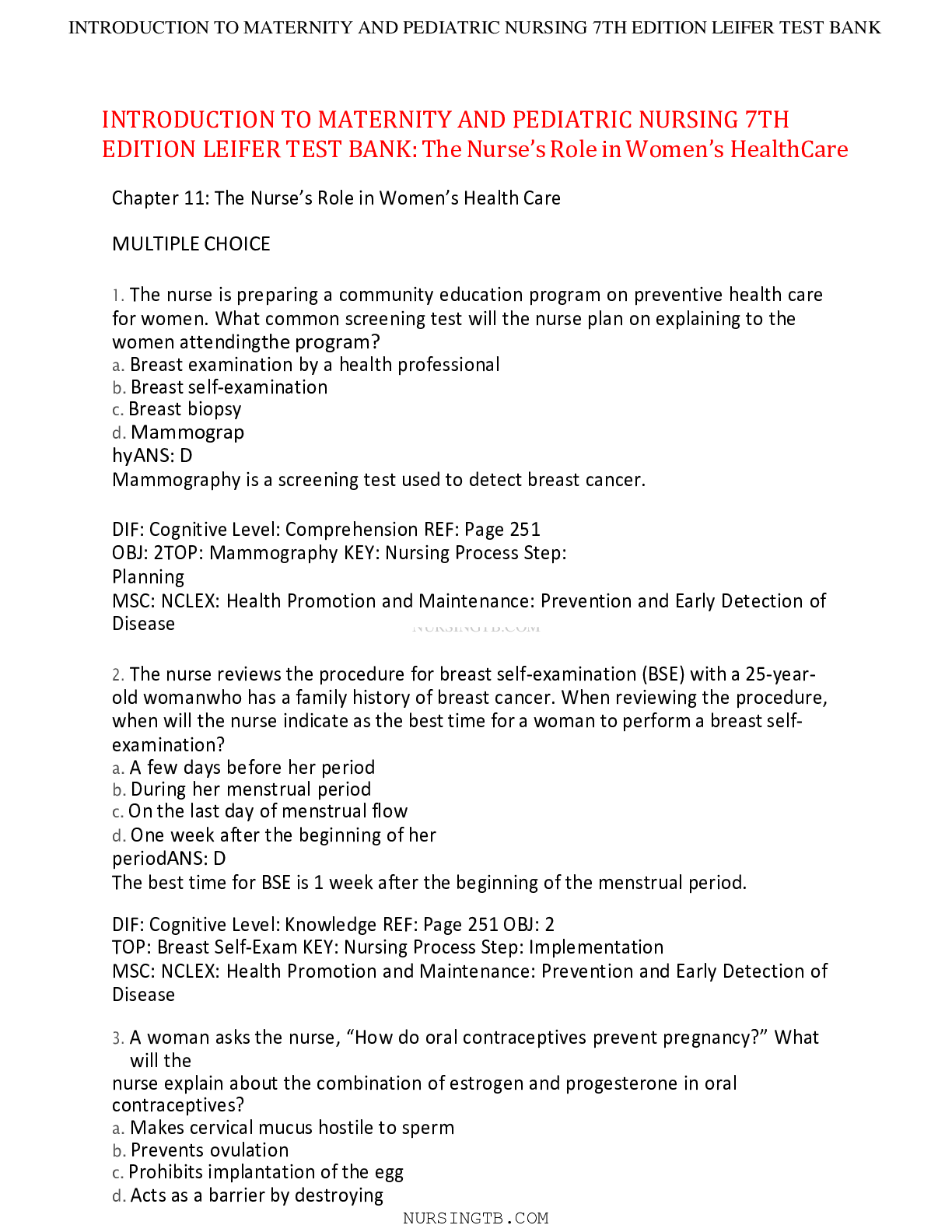
Reviews( 0 )
Document information
Connected school, study & course
About the document
Uploaded On
Dec 20, 2022
Number of pages
23
Written in
Additional information
This document has been written for:
Uploaded
Dec 20, 2022
Downloads
0
Views
41

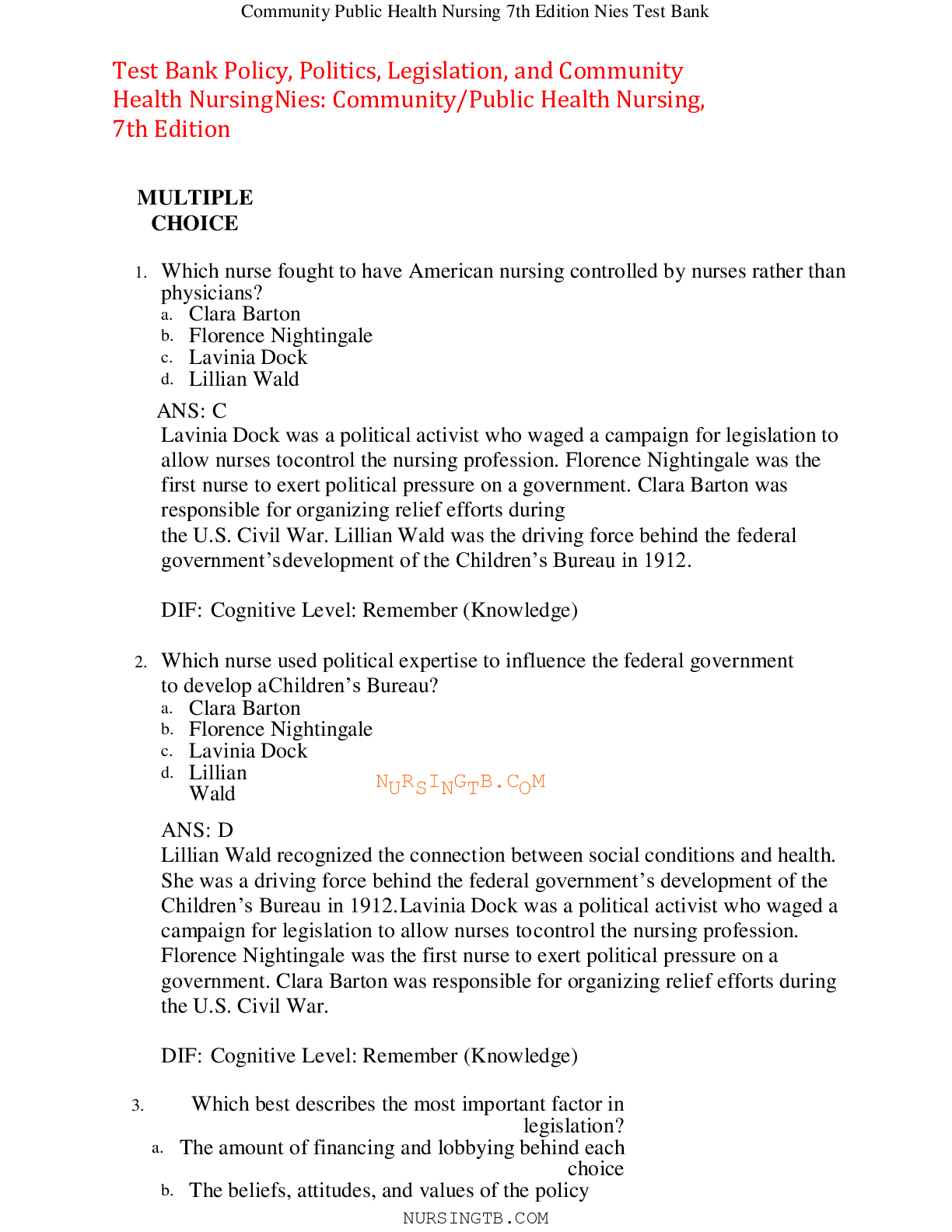


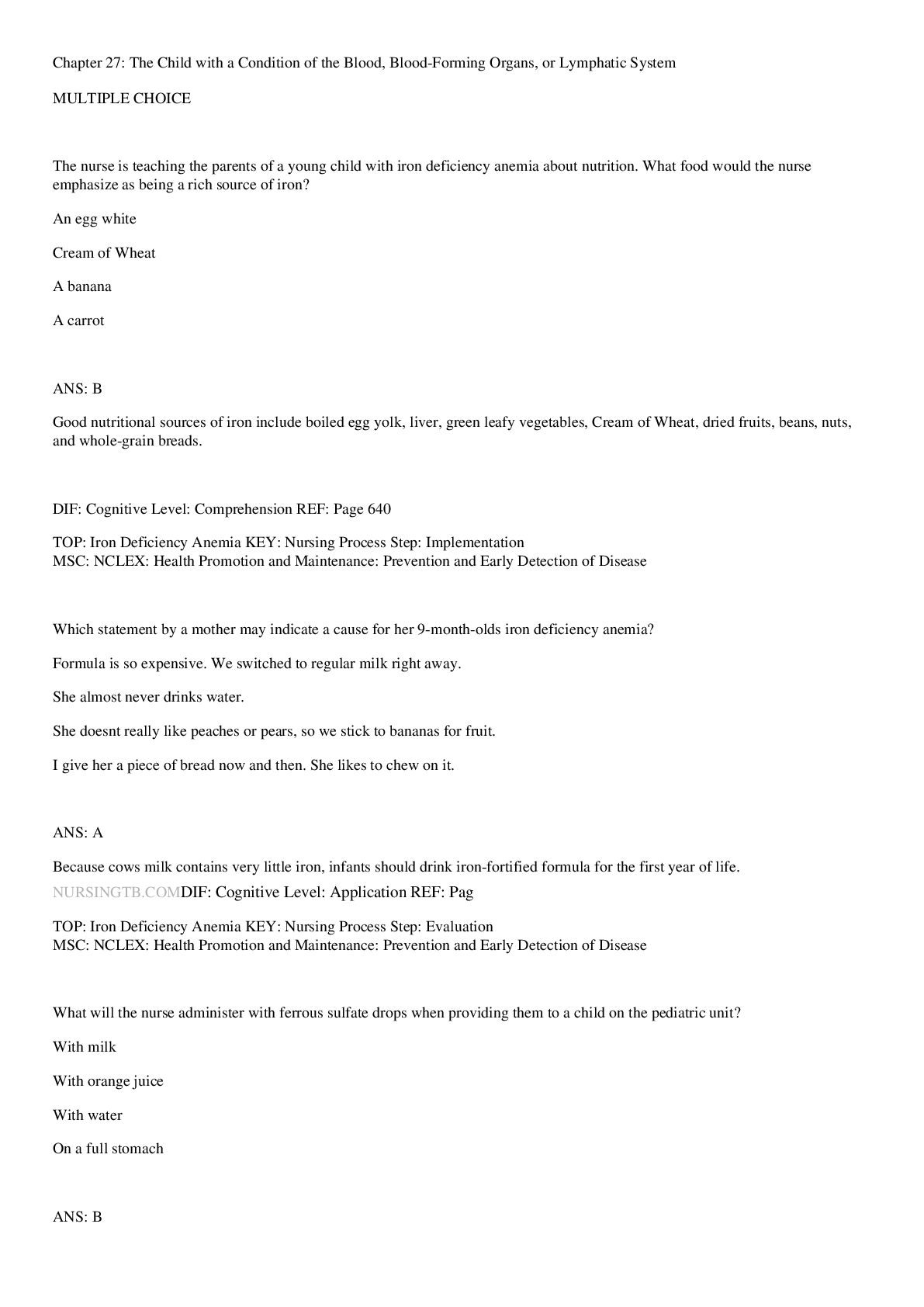



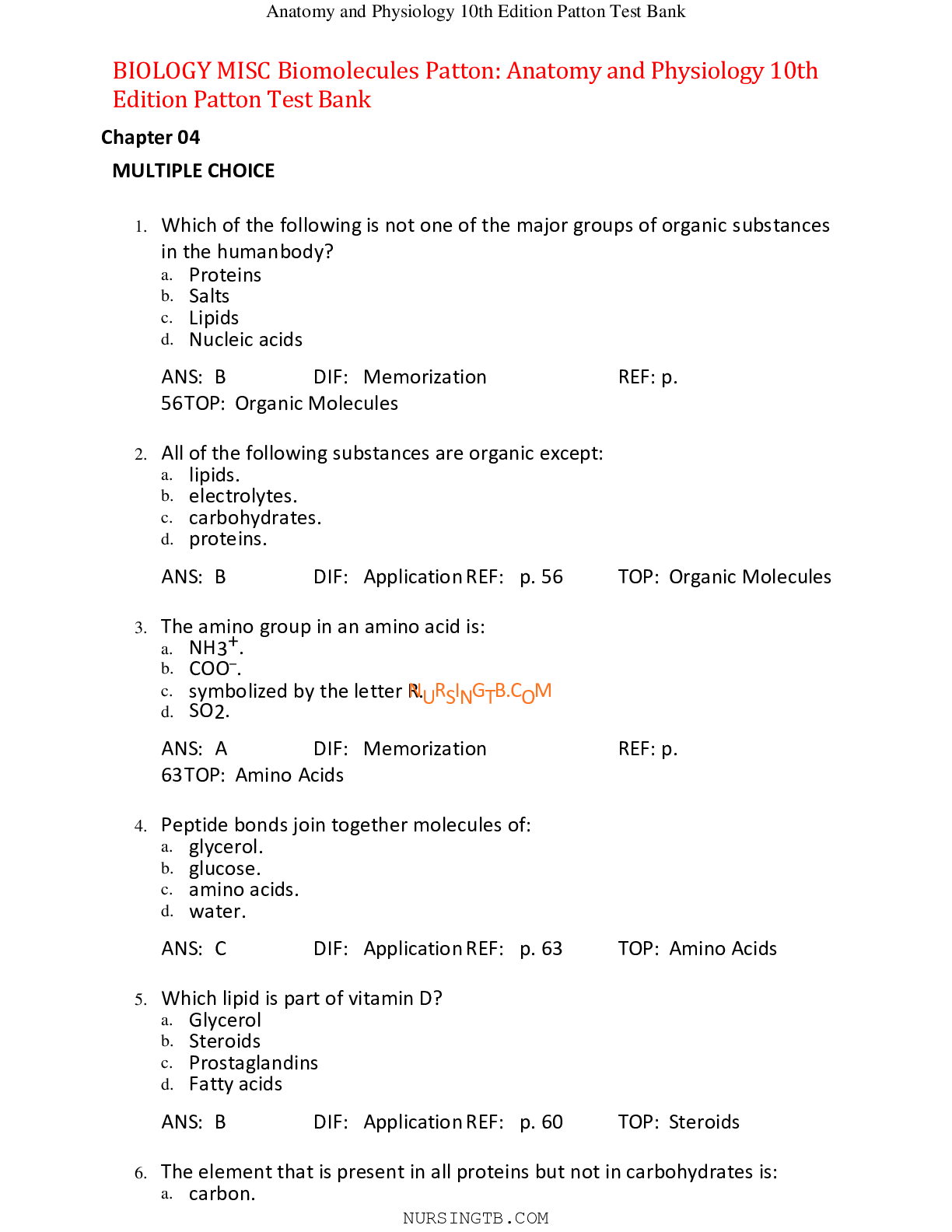







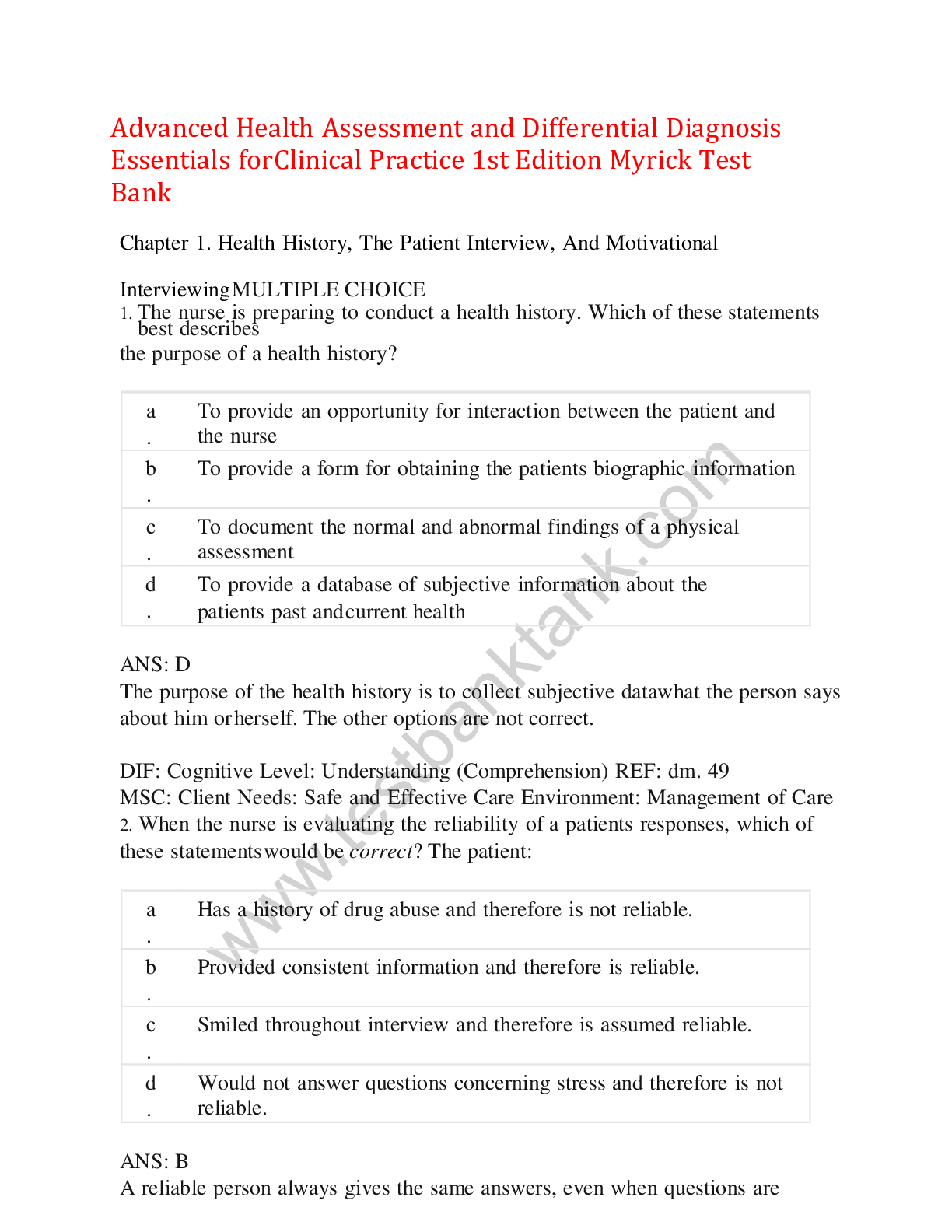




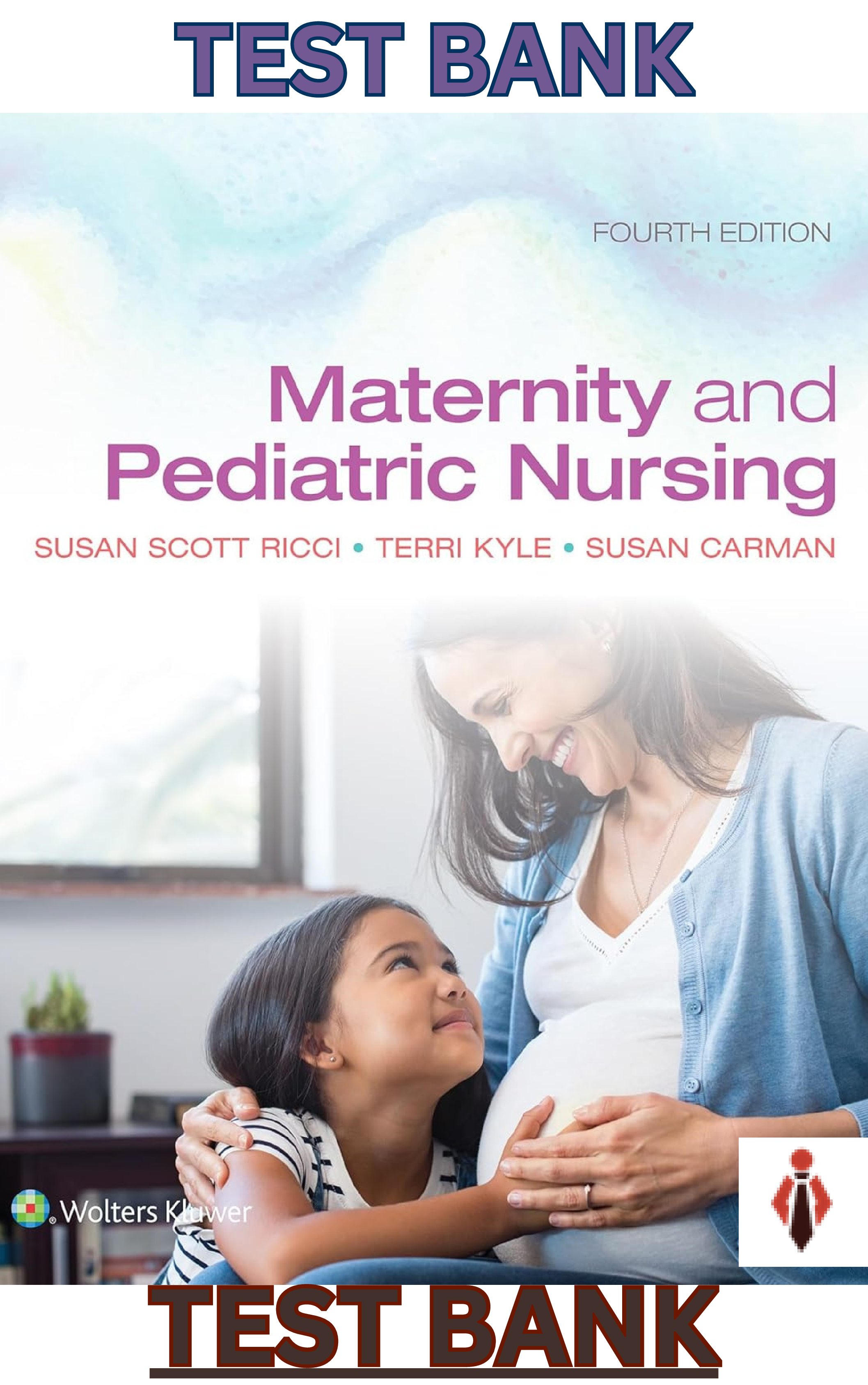
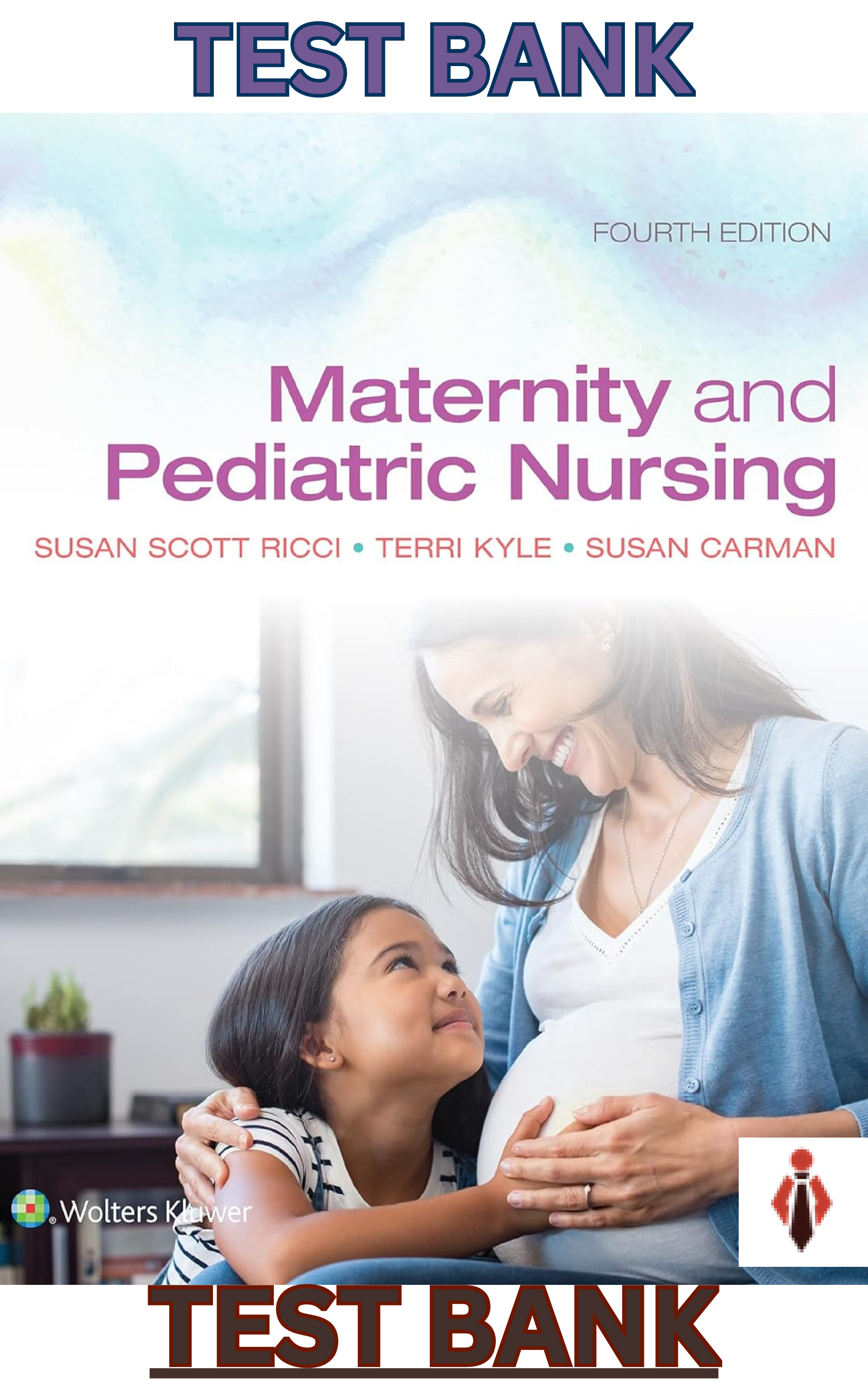
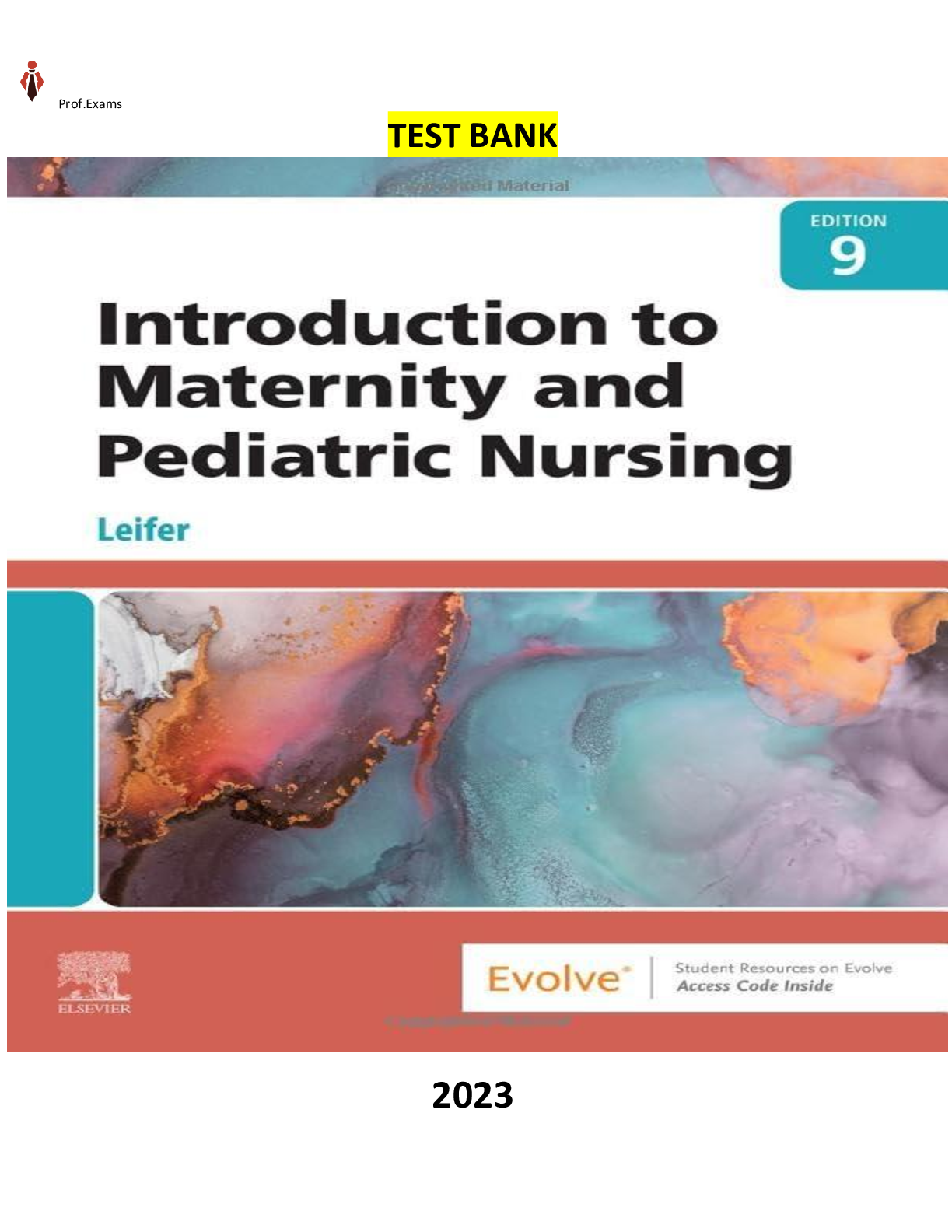
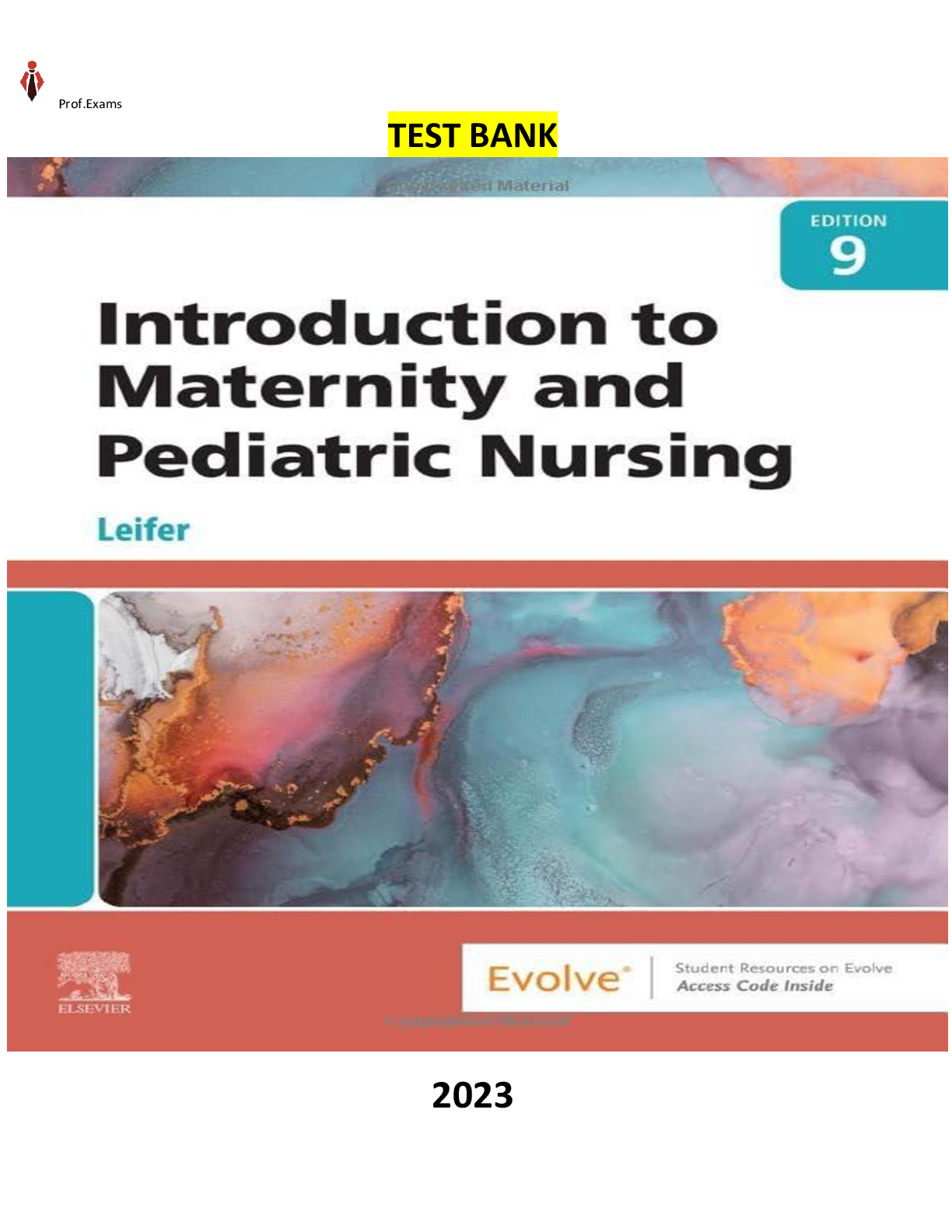
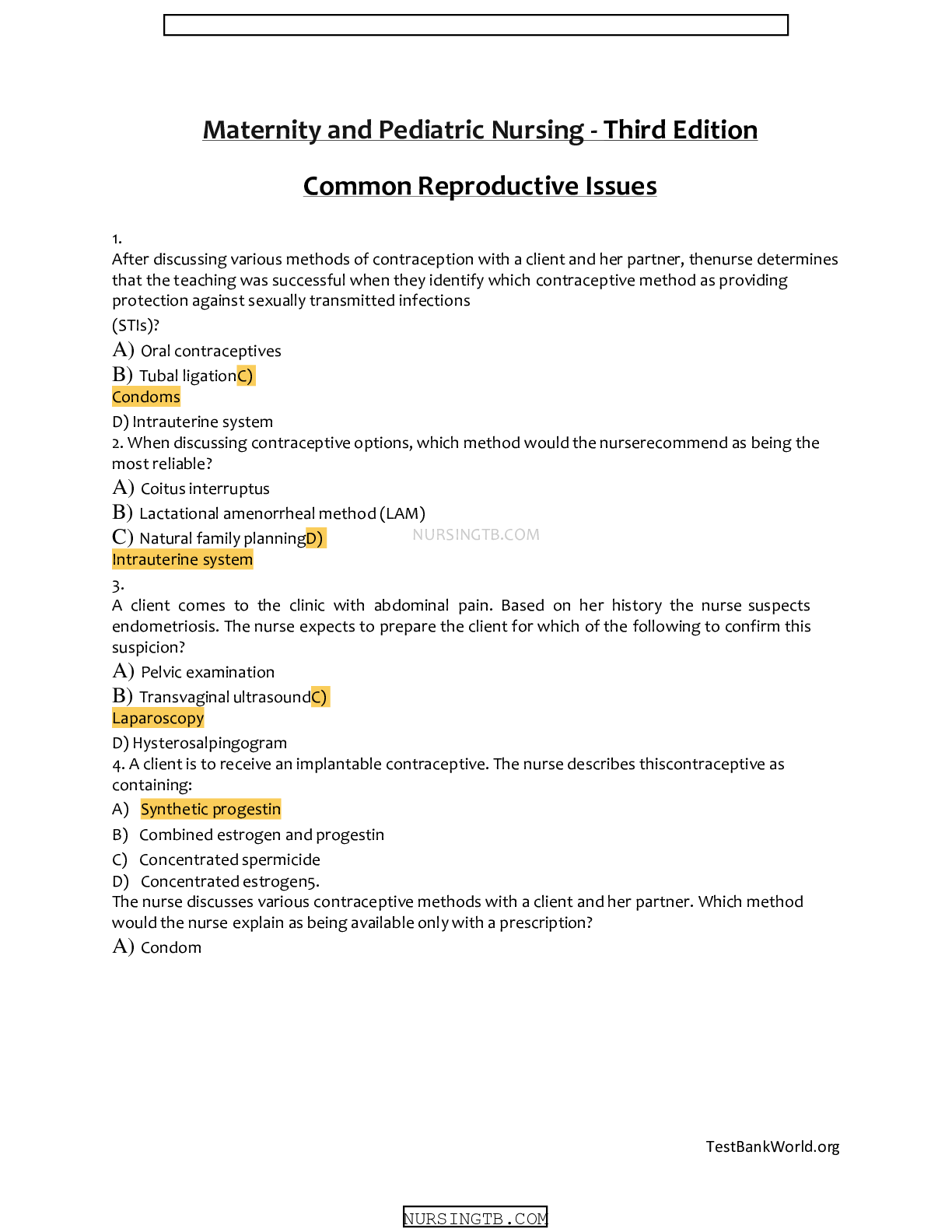
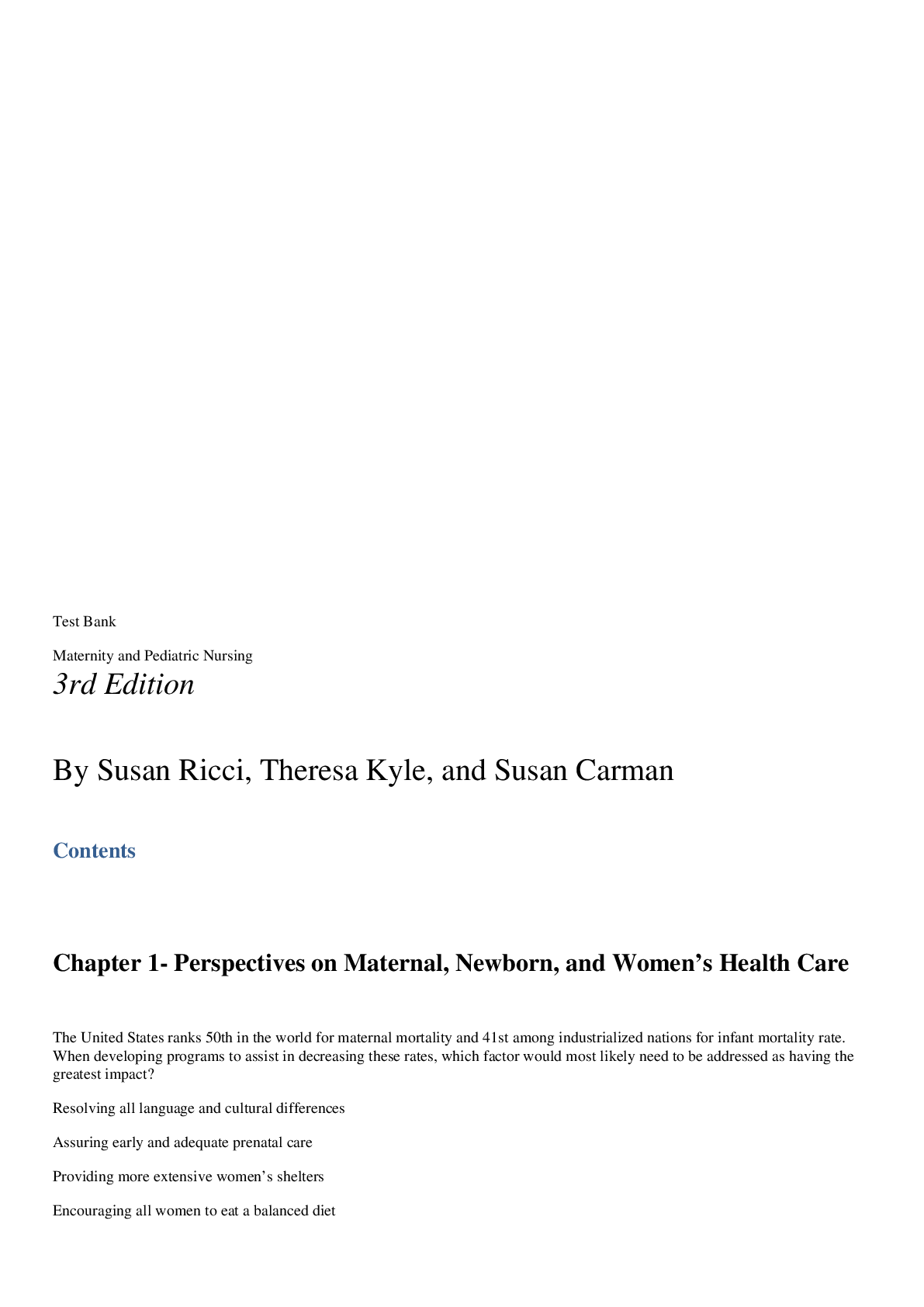
.png)
